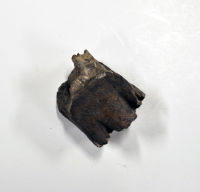Tooth - Woolly Rhinoceros
Object
Fossil
Production date
300,000BC=8,000BC)
Object number
1991.882
Physical Description
Lower molar tooth of a woolly rhino. Identification confirmed by Prof. Adrian Lister.
Object history
Tooth, woolly rhino, found in Stoke Newington.
Associated Place
Material
Bone
Dimension
Height (Whole): 65mm
Width (Whole): 50mm
Depth (Whole): 30mm
Width (Whole): 50mm
Depth (Whole): 30mm
Exhibition Label
From ‘Hackney 300,000 BC: Meet the Neanderthal neighbours and curious creatures of the borough's Old Stone Age’
Woolly Rhinoceros
(300,000 - 10,000 years ago)
Around 300,000 years ago, the warm climate was replaced by a cooler period lasting 60,000 years. This led to the appearance of animals suited to these conditions.
The woolly rhino was covered in thick, reddish-brown hair to protect against cold weather. Their impressive horns measured 2 feet long.
The species went extinct, when warming conditions replaced their preferred habitat of huge open grasslands with woodland.
This tooth was found in Stoke Newington, while the leg bone was discovered in the Thames Valley and owned by a local collector Mr Soul.
Woolly Rhinoceros
(300,000 - 10,000 years ago)
Around 300,000 years ago, the warm climate was replaced by a cooler period lasting 60,000 years. This led to the appearance of animals suited to these conditions.
The woolly rhino was covered in thick, reddish-brown hair to protect against cold weather. Their impressive horns measured 2 feet long.
The species went extinct, when warming conditions replaced their preferred habitat of huge open grasslands with woodland.
This tooth was found in Stoke Newington, while the leg bone was discovered in the Thames Valley and owned by a local collector Mr Soul.
On display?
No
Inscription
VIII in ink


